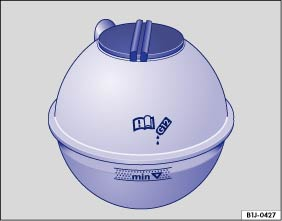Volkswagen Polo Owners Manual: Checking the coolant level and refilling coolant

Fig. 139 In the engine compartment: mark on the coolant expansion tank

Fig. 140 In the engine compartment: coolant expansion tank cap
 First read and observe the introductory information
and safety warnings
First read and observe the introductory information
and safety warningsThe warning lamp for the engine coolant will light up if the engine coolant level is too low.
Preparation
- Park the vehicle on a firm and level surface.
- Allow the engine to cool down .
- Open the bonnet
 .
.
- The coolant expansion tank has the
 symbol on its cap .
symbol on its cap .
Checking the coolant level
- Check the coolant level at the side marking of the expansion tank when the engine is cold .
- Refill the coolant if the liquid level is below the minimum marking (min). When the engine is warm, the coolant level may be slightly above the top end of the marked area.
Refilling coolant
- Always protect your hands and arms from hot coolant or steam by placing a suitable cloth on the cap of the coolant expansion tank.
- Unscrew the cap carefully .
- Refill only new coolant according to the Volkswagen specification ( ) .
- The coolant level must be between the marks on the expansion tank . Do not fill up over the top line of the marked area !
- Close the cap tightly.
- If in an emergency you do not have access to the coolant of the required specification ( ), do not use any other coolant additive. Instead, initially refill with distilled water only. Then add the correct proportion of coolant additive as soon as possible .

 WARNING
WARNING
- Never open the bonnet if you can see or hear steam or engine coolant coming out of the engine compartment. Always wait until you can no longer see or hear steam or coolant escaping.
- Always allow the engine to cool down completely before carefully opening the bonnet. Hot components can burn the skin.
- The following points should be noted before opening the bonnet once it has
cooled down.
- Apply the handbrake fully and move the selector lever to position P or move the manual gear lever to the neutral position.
- Remove the vehicle key from the ignition lock.
- Always keep children away from the engine compartment and never leave the vehicle unattended.
- The engine cooling system is under pressure when the engine is hot. Never
open the cap of the coolant expansion tank when the engine is hot. Coolant may
spray out and cause serious burns and injuries.
- Turn the cap slowly and very carefully anticlockwise while exerting some downward pressure on the cap.
- Always protect the face, hands and arms from hot coolant or steam with a large, thick cloth.
- When refilling, do not spill any service fluids on engine components or on the exhaust system. The spilt service fluids can start a fire. In certain circumstances, the ethylene glycol in the engine can catch fire.

 NOTICE
NOTICE
- Refill only with distilled water. All other types of water can cause corrosion in the engine due to the chemical components contained therein. This can also lead to engine failure. If any other type of water is refilled, the fluid in the engine cooling system should be completely replaced immediately by a qualified workshop.
- Do not fill coolant above the top of the marked area . Otherwise the excess coolant will be pressed out of the cooling system when the engine is hot and could cause damage.
- If a large amount of coolant has been lost, do not refill the coolant until the engine has cooled completely. Heavy coolant loss is an indication of leaks in the engine cooling system. The engine cooling system should be checked by a qualified workshop as soon as possible. Failure to do so can result in engine damage.
- When refilling operating fluids, please ensure that the correct container is filled. The use of incorrect operating fluids could result in serious malfunctions and engine damage!
 Coolant specification
Coolant specification
First read and observe the introductory information
and safety warningsThe cooling system is filled at the factory with a mixture
of specially prepared water and at least 40% coolant additive G 13 ...
 Vehicle battery
Vehicle battery
...
Other materials:
Secondary Lock
The secondary lock is a housing securing mechanism (second
locking mechanism) that secures all wires in one contact
housing. If a secondary lock is installed at a contact housing,
it must always be opened or removed using specified tool before
releasing ...
Cleaning and changing windscreen wiper blades
Fig. 142 Variants A and B: Changing the
windscreen wiper blades. Variants B and C: Changing the rear window wiper blade
First read and observe the introductory information
and safety warningsThe factory-fitted windscreen/window wiper blades are
coated with graphite. The graphite coating ens ...
Main menu
First read and observe the introductory
information and safety warnings
Menu
Function
See
MFD
Information and settings for the multifunction
display (MFD).
Audio
Station display in radio mode.
Trac ...
